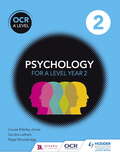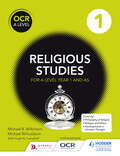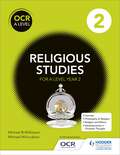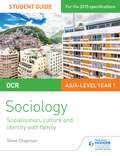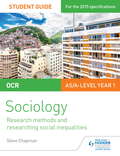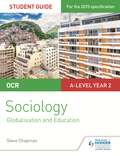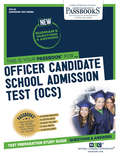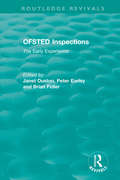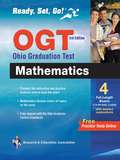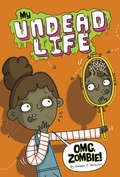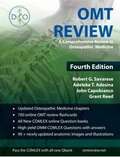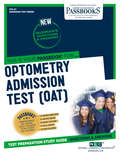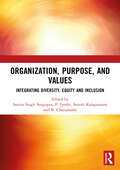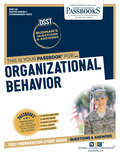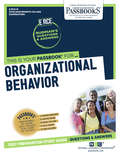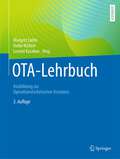- Table View
- List View
OCR Psychology for A Level Book 2
by Louise Ellerby-Jones Nigel Wooldridge Sandra LathamExam Board: OCRLevel: A-levelSubject: PsychologyFirst Teaching: September 2015First Exam: June 2016OCR Publishing Partner Helps your students build their knowledge of the core studies and applied topics for OCR Psychology with a clear, organised approach; activities, practice questions and extension suggestions develop the skills required at A Level- Supports you and your students through the new OCR A Level specification, with an author team experienced in teaching and examining OCR Psychology- Helps students easily navigate the core studies and associated themes and perspectives with an organised, accessible approach- Develops knowledge and understanding of all the Applied Psychology topics, with background, key studies and applications- Develops the critical thinking, mathematical and problem-solving skills required for the study of Psychology through a wealth of targeted activities- Strengthens students' learning and progression with practice questions and extension activities
OCR Religious Studies A Level Year 1 and AS: Philosophy And Ethics Year 1 And As
by Michael Wilkinson Michael Wilcockson Hugh CampbellHelp students to build their subject knowledge and understanding with guidance and assessment preparation from a team of subject specialists; brought to you by the leading Religious Studies publisher and OCR's Publishing Partner.- Develops students' understanding of 'Philosophy of religion' and 'Religion and ethics' through accessible explanations of key theories and terms- Enables you to teach 'Developments in Christian thought' confidently with comprehensive coverage of the key theological arguments- Supports assessment preparation with sample questions and revision advice written by subject specialists- Encourages students to reflect on their learning and develop their own ideas- Helps to extend learning and enhance responses with suggested ideas and additional readingContent covered:- Philosophy of religion- Religion and ethics- Developments in Christian thought
OCR Religious Studies A Level Year 1 and AS: Philosophy And Ethics Year 1 And As
by Michael Wilkinson Michael Wilcockson Hugh CampbellExam Board: OCRLevel: A-LevelSubject: Religious StudiesFirst Teaching: September 2016First Exam: Spring 2017An OCR endorsed textbookHelp students to build their subject knowledge and understanding with guidance and assessment preparation from a team of subject specialists; brought to you by the leading Religious Studies publisher and OCR's Publishing Partner.- Develops students' understanding of 'Philosophy of religion' and 'Religion and ethics' through accessible explanations of key theories and terms- Enables you to teach 'Developments in Christian thought' confidently with comprehensive coverage of the key theological arguments- Supports assessment preparation with sample questions and revision advice written by subject specialists- Encourages students to reflect on their learning and develop their own ideas- Helps to extend learning and enhance responses with suggested ideas and additional readingContent covered:- Philosophy of religion- Religion and ethics- Developments in Christian thought
OCR Religious Studies A Level Year 2
by Michael Wilkinson Michael WilcocksonExam Board: OCRLevel: A-levelSubject: Religious StudiesFirst Teaching: September 2016First Exam: June 2018An OCR endorsed textbookHelp students to build their subject knowledge and understanding with guidance and assessment preparation from a team of subject specialists; brought to you by the leading Religious Studies publisher and OCR's Publishing Partner.- Develops students' understanding of 'Philosophy of religion' and 'Religion and ethics' through accessible explanations of key theories and terms- Enables you to teach 'Developments in Christian thought' confidently with comprehensive coverage of the key theological arguments- Supports assessment preparation with sample questions and revision advice written by subject specialists- Encourages students to reflect on their learning and develop their own ideas- Helps to extend learning and enhance responses with suggested ideas and additional readingContent covered:- Philosophy of religion- Religion and ethics- Developments in Christian thought
OCR Religious Studies A Level Year 2
by Michael Wilkinson Michael WilcocksonExam Board: OCRLevel: A-levelSubject: Religious StudiesFirst Teaching: September 2016First Exam: June 2018An OCR endorsed textbookHelp students to build their subject knowledge and understanding with guidance and assessment preparation from a team of subject specialists; brought to you by the leading Religious Studies publisher and OCR's Publishing Partner.- Develops students' understanding of 'Philosophy of religion' and 'Religion and ethics' through accessible explanations of key theories and terms- Enables you to teach 'Developments in Christian thought' confidently with comprehensive coverage of the key theological arguments- Supports assessment preparation with sample questions and revision advice written by subject specialists- Encourages students to reflect on their learning and develop their own ideas- Helps to extend learning and enhance responses with suggested ideas and additional readingContent covered:- Philosophy of religion- Religion and ethics- Developments in Christian thought
OCR Religious Studies A Level Year 2
by Michael Wilkinson Michael WilcocksonExam Board: OCRLevel: A-levelSubject: Religious StudiesFirst Teaching: September 2016First Exam: June 2018An OCR endorsed textbookHelp students to build their subject knowledge and understanding with guidance and assessment preparation from a team of subject specialists; brought to you by the leading Religious Studies publisher and OCR's Publishing Partner.- Develops students' understanding of 'Philosophy of religion' and 'Religion and ethics' through accessible explanations of key theories and terms- Enables you to teach 'Developments in Christian thought' confidently with comprehensive coverage of the key theological arguments- Supports assessment preparation with sample questions and revision advice written by subject specialists- Encourages students to reflect on their learning and develop their own ideas- Helps to extend learning and enhance responses with suggested ideas and additional readingContent covered:- Philosophy of religion- Religion and ethics- Developments in Christian thought
OCR Sociology Student Guide 1: Socialisation, culture and identity with family
by Steve ChapmanWritten by experienced teacher Steve Chapman, this Student Guide for Sociology:- Identifies the key content you need to know with a concise summary of topics examined in the AS and A-level specifications- Enables you to measure your understanding with exam tips and knowledge check questions, with answers at the end of the guide- Helps you to improve your exam technique with sample answers to exam-style questions- Develops your independent learning skills with content you can use for further study and research
OCR Sociology Student Guide 2: Researching and understanding social inequalities
by Steve ChapmanWritten by experienced teacher Steve Chapman, this Student Guide for Sociology:- Identifies the key content you need to know with a concise summary of topics examined in the AS and A-level specifications- Enables you to measure your understanding with exam tips and knowledge check questions, with answers at the end of the guide- Helps you to improve your exam technique with sample answers to exam-style questions- Develops your independent learning skills with content you can use for further study and researchContentsSection A: Research methods and researching social inequalities - What is the relationship between theory and methods?- What are the main stages of the research process? - Which methods are used in sociological research? Section B: Understanding social inequalities- What are the main patterns and trends in social inequality and difference? - How can patterns and trends in social inequality and difference be explained?
OCR Sociology Student Guide 4: Globalisation and the digital social world; Education
by Katherine Roberts Steve Chapman Lesley ConnorExam Board: OCRLevel: A-levelSubject: SociologyFirst Teaching: September 2015First Exam: September 2017Reinforce students' understanding throughout their course; clear topic summaries with sample questions and answers will improve exam technique to achieve higher grades.Written by examiners and teachers, Student Guides:- Help students identify what they need to know with a concise summary of the theme examined in the A-level specification- Consolidate understanding with exam tips and knowledge check questions- Provide opportunities to improve exam technique with sample graded answers to exam-style questions- Develop independent learning and research skills - Provide the content for generating individual revision notes
OCR Sociology for A Level Book 1
by Katherine Roberts Paul Taylor Sue Brisbane Steve Chapman Jannine Jacobs-Roth Nayda AliExam Board: OCRLevel: A-levelSubject: SociologyFirst Teaching: September 2015First Exam: June 2016Build students' confidence to tackle the key themes of the 2015 OCR A-Level Sociology specification with this clear and accessible approach delivered by a team of leading subject authors.- Develop knowledge and understanding of key Year 1 concepts in a contemporary context, including globalisation and the digital social world- Strengthen essential sociological skills with engaging activities at every stage of the course- Reinforce learning and prepare for exams with practice and extension questions and exercises
OCR Sociology for A Level Book 1
by Katherine Roberts Paul Taylor Sue BrisbaneOur experienced author team combines detailed focus on contemporary society, including globalisation and the digital social world, with engaging activities to develop essential sociological skills.- Develop knowledge and understanding of key sociological concepts in a contemporary context- Strengthen learning and revision through each stage of the course with plenty of practice and extension exercises- Develop sociological skills with practical activities
OCR Sociology for A Level Book 1
by Katherine Roberts Paul Taylor Sue BrisbaneExam Board: OCRLevel: A-levelSubject: SociologyFirst Teaching: September 2015First Exam: June 2016Build students' confidence to tackle the key themes of the 2015 OCR A-Level Sociology specification with this clear and accessible approach delivered by a team of leading subject authors.- Develop knowledge and understanding of key Year 1 concepts in a contemporary context, including globalisation and the digital social world- Strengthen essential sociological skills with engaging activities at every stage of the course- Reinforce learning and prepare for exams with practice and extension questions and exercises
OCR Sociology for A Level Book 2
by Katherine Roberts Paul Taylor Laura Pountney Sue BrisbaneExam Board: OCRLevel: A-levelSubject: SociologyFirst Teaching: September 2015First Exam: June 2017Build students' confidence to tackle the key themes of the 2015 OCR A-Level Sociology specification with this clear and accessible approach delivered by a team of leading subject authors.- Develop knowledge and understanding of key Year 2 concepts in a contemporary context, including globalisation and the digital social world- Strengthen essential sociological skills with engaging activities at every stage of the course- Reinforce learning and prepare for exams with practice and extension questions and exercises
OFFICER CANDIDATE SCHOOL ADMISSION TEST: Passbooks Study Guide (Admission Test Series)
by National Learning CorporationThe Admission Test Series prepares students for entrance examinations into college, graduate and professional school as well as candidates for professional certification and licensure. The Officer Candidate School Admission Test (OCS) Passbook® prepares you by sharpening the skills and abilities necessary to succeed on your upcoming entrance exam. It provides hundreds of questions and answers in the areas that will likely be covered on your upcoming exam.
OFSTED Inspections: The Early Experience (Routledge Revivals)
by Peter Earley Janet Ouston Brian FidlerThe national programme of four-yearly school inspections was introduced in 1993, based on common criteria set out in OFSTED’s Handbook for the Inspection of Schools. Revised guidelines were introduced in February 1996, reflecting the lessons learned, and this book, originally published in 1996 articulates ideas that would have informed these revisions, including short essays by the Secretary of State for Education and Employment and the Education spokesmen of the Labour and Liberal Democrat parties. Registered inspectors, teachers, researchers, parents, school governors, policy analysts and policy makers all offer their experience of the strengths, weaknesses and outcomes of the OFSTED inspection process. The book is a companion to Improvement through Inspection? – Complementary Approaches to School Development by the same Editors, published and now reissued simultaneously.
OGT Ohio Graduation Test Mathematics 3rd Ed. (Ohio Graduation Test (ogt) Test Prep Ser.)
by J. BriceEvery student in Ohio must pass the OGT - Are you ready for the OGT Mathematics exam? REA's OGT Mathematics test prep with bonus online tests helps you sharpen your skills and pass the exam! This second edition of our popular test prep provides the up-to-date instruction and practice high school students need to improve their math skills and pass this state-required exam. Based on Ohio's Academic Content Standards for Mathematics, the comprehensive review features student-friendly, easy-to-follow lessons and examples that reinforce the key concepts tested on the OGT mathematics exam, including: * Data Analysis and Probability * Geometry and Spatial Sense * Measurement * Patterns * Functions * Algebra Focused lessons explain math principles in easy-to-understand language that's suitable for students at any learning level. Our tutorials and targeted drills increase comprehension while enhancing your skills. Color icons and graphics throughout the book highlight must-know concepts. Test-taking tips and strategies in each chapter give you an added boost of confidence so you can do your best on the exam. Four practice exams help you prepare for the OGT! The book contains two full-length practice exams that allow you to test your knowledge while reinforcing what you have learned. Two additional practice tests not found in the book are available online - for a total of four exams! Each practice test comes complete with detailed explanations of answers, allowing you to focus on areas in need of further study. Whether used in a classroom, at home for self-study, or as a textbook supplement, Ohio teachers, parents, and students will consider this book a "must-have" prep for the OGT. REA test preps and software have proven to be the extra support students need to pass their challenging state-required tests. Our comprehensive test preps are teacher-recommended and written by experienced educators.
OMG, Zombie! (My Undead Life)
by Emma T. GravesAfter suffering through school's mystery lunch, twelve-year-old Tulah Jones does NOT feel right. She's craving meat, cold as a corpse, and feeling stiff and awkward . . . Tulah tries to ignore the creepy changes and instead focus on her upcoming musical audition. But when her fears about the tryout-and her weird affliction-start to fester, will Tulah have the guts to face her problems head on? Featuring hordes of comic art and hilarious misadventures, kids will eagerly devour this tale of undead tween life.
OMT Review: Comprehensive Review in Osteopathic Medicine
by Robert Savarese Adeleke Adesina John Capobianco Grant ReedOMT Review: A Comprehensive Review in Osteopathic Medicine
OPN 101 Adhyayan Kaushalyancha Adhishthan Abhyaskram F.Y.B.A. - Y.C.M.O.U
by Usha Khire Anjali Saygavakar Sau. Vadadekar Rajendra Vadanere Prof. Pande Shree. KumbharOPN 101 Adhyayan Kaushalyancha Adhishthan Abhyaskram text book for F.Y.B.A from Yashwantrao Chavan Maharashtra Open University, Nashik in Marathi.
OPTOMETRY ADMISSION TEST: Passbooks Study Guide (Admission Test Series)
by National Learning CorporationThe Admission Test Series prepares students for entrance examinations into college, graduate and professional school as well as candidates for professional certification and licensure. The Optometry Admission Test (OAT) Passbook® prepares you by sharpening the skills and abilities necessary to succeed on your upcoming entrance exam. It provides a series of informational texts as well as hundreds of questions and answers in the areas that will likely be covered on your upcoming exam, including but not limited to: biology; chemistry; scientific reading comprehension; quantitative reasoning; physics; and more.
ORGANIZATION, PURPOSE, AND VALUES: INTEGRATING DIVERSITY, EQUITY AND INCLUSION
People (employees and investors) are the strength of the organizations and the leader who integrates this understanding creates an environment where people can use their full potential, feel appreciated and grow in the process. Organizations need to promote leadership that is able to nurture the spirit of each employee in order to create happy and harmonious workplaces. Such a nurturing and liberating environment will trigger social energy, which is not only a sufficient condition for innovation but the precondition for creating collective pride.
ORGANIZATIONAL BEHAVIOR: Passbooks Study Guide (DANTES Subject Standardized Tests (DSST) #Vol. Dantes-49)
by National Learning CorporationThe DSST Subject Standardized Tests are comprehensive college and graduate level examinations given by the Armed Forces, colleges and graduate schools. These exams enable students to earn college credit for what they have learned through self-study, on the job, or by other non-traditional means. The DSST Organizational Behavior Passbook® prepares candidates for the DSST exam, which enables schools to award credit for knowledge acquired outside the normal classroom environment. It provides informational text as well as hundreds of questions and answers in the areas that will likely be covered on your upcoming exam, including but not limited to: definitions and concepts; individual and group processes and characteristics; organizational structure; and more.
ORGANIZATIONAL BEHAVIOR: Passbooks Study Guide (Excelsior/Regents College Examination Series #Vol. Dantes-49)
by National Learning CorporationThe Excelsior/Regents College Examinations (E/RCE) offer you an opportunity to obtain recognition for college-level learning and consists of exams designed to demonstrate achievement and mastery of various college-level subjects, such as the Arts and Sciences, Business, Criminal Justice, Education, Health and Nursing. The E/RCE Organizational Behavior Passbook® prepares you by sharpening knowledge of the skills and concepts necessary to succeed on the upcoming exam and the college courses that follow. It provides a series of informational texts as well as hundreds of questions and answers in the areas that will likely be covered on your upcoming exam.
OTA-Lehrbuch: Ausbildung zur Operationstechnischen Assistenz
by Margret Liehn Heike Richter Leonid KasakovDer Beruf der OTA ist vielseitig, interessant und abwechslungsreich. Dieses Lehrbuch begleitet die Auszubildenden in ihrer dreijährigen Ausbildung und richtet sich nach der aktuellen Ausbildungs- und Prüfungsverordnung und dem aktuellen Anästhesietechnischen und Operationstechnischen Assistentengesetz (ATA-OTA-G) vom 14. Dezember 2019: Jedem Kapitel sind die jeweiligen Kompetenzschwerpunkte vorangestellt.Systematisch finden sich alle Aufgabenbereiche der Ausbildung wie Hygiene, Instrumentanz, Qualitätsmangement, die unterschiedlichen Einsatzorte wie Notaufnahme, Endoskopie und AEMP sowie die notwendigen gesetzlichen Grundlagen. Fallbeispiele, Merksätze und Praxistipps erleichtern das Lernen, zahlreiche Abbildungen und Grafiken veranschaulichen Zusammenhänge, eine Zusammenfassung am Ende des Kapitels und Fragen helfen das Gelernte zu überprüfen.Neu in der 3. Auflage: kurzer Überblick der Anatomie zu allen chirurgischen Themen, Zusammenfassungen nach jedem Themengebiet, Definitionen spezieller Begriffe sowie aktuelle Themen. Ideal für ein Lernen ohne medizinische und pflegerische Vorkenntnisse: Für Auszubildende zum täglichen Gebrauch und erfolgreichen Lernen, für Lehrende und Dozenten die ideale Vorbereitung auf den Unterricht! Empfohlen vom Deutschen OTA-Schulträgerverband.
Oakdale: The Lapeer State Home
by Jan Gillis Laura FromwillerThe Lapeer State Home has been a large part of the history of Lapeer County since its beginnings in 1895. After starting with three buildings and housing for 200 patients, the facility grew to encompass several hundred acres and, at its peak, accommodating over 4,000 patients. The history of the home includes a variety of memories from staff members, patients, and visitors who once walked its halls. Images of America: Oakdale: The Lapeer State Home provides a journey of this historic institution and attempts to bring some clarity to questions that remain about the home and its past.
